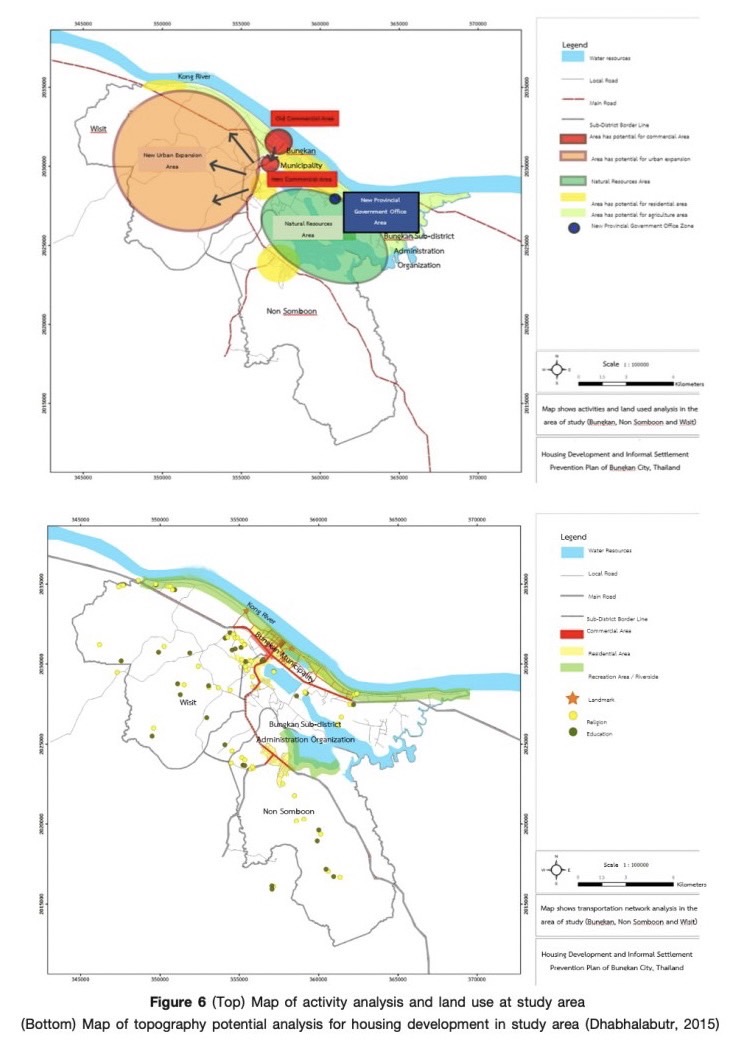Housing Development and Informal Settlement Prevention Plan of Bungkan City, Thailand
Main Article Content
Abstract
An important challenge to delivering adequate housing solutions in Thailand is associated with management problems that lack an effective mechanism to connect between concerned organizations. It is necessary to equip local stakeholders with housing management capacity under a participatory process. In this project, a housing development plan that included extensive community participation was delivered to Bungkan province which is the most recently established province in Thailand (2011) and as such, still lacked such a plan. The research project, “Housing Development and Informal Settlement Prevention Plan of Bungkan City” was conducted collaboratively by the National Housing Authority of Thailand and Khon Kaen University. The three major research objectives were to: formulate a city housing development plan for Bungkan city; create a participatory process of stakeholders that empowered their capacity through the planning process; and create a mechanism for housing development which connects key agencies from the national level to the local community. The research applied the Ladder of Participation (Arnstein, 1969) as the theoretical framework, with a mixed scale of the ladders including Consultation, Partnership, and Delegated Power. Data gathering and the planning process used a mixed method approach that included geospatial analysis through a Geographic Information System application, in-depth interviews, a questionnaire survey, stakeholder meetings, study trips, workshops, and exhibitions. At the end of project, the research achieved a housing development plan for Bungkan city with a new vision that included 5 strategies, 12 plans, and 46 projects. The research found that the key factor of project success was stakeholder’s inclusion at the beginning stage to the last stage of operation. In particular, the partnership concept in the form of joint committees shaped trustworthy relationships between stakeholders and allowed them to share a sense of ownership.
Downloads
Article Details

This work is licensed under a Creative Commons Attribution-NonCommercial-NoDerivatives 4.0 International License.
All material is licensed under the terms of the Creative Commons Attribution 4.0 International (CC-BY-NC-ND 4.0) License, unless otherwise stated. As such, authors are free to share, copy, and redistribute the material in any medium or format. The authors must give appropriate credit, provide a link to the license, and indicate if changes were made. The authors may do so in any reasonable manner, but not in any way that suggests the licensor endorses you or your use. The authors may not use the material for commercial purposes. If the authors remix, transform, or build upon the material, they may not distribute the modified material, unless permission is obtained from JARS. Final, accepted versions of the paper may be posted on third party repositories, provided appropriate acknowledgement to the original source is clearly noted.
References
Arnstein, S. R. (1969). A ladder of citizen participation. Journal of the American Institute of Planners, 35(4), 216.
Bungkan Adminstration Office. (2013). Bungkan Provincial Development Plan 4 Years (2014-2017).
Dhabhalabutr, K. (2020). Community participation in architectural design and planning as a method for heritage site conservation and development case study: Nong Kud Thing, Bungkarn Province, Thailand. In E. Banissi et al., (Eds.). 2020 24th International Conference Information Visualisation (IV) (pp. 599-602). IEEE.
Dhabhalabutr, K., Benjaranonda, M., & Tantivess, N. (2015). Housing development and informal settlement prevention plan of Bungkan City, Thailand. National Housing Authority of Thailand.
Fürst, D. (2018). Planung. ARL (Hg.): Handwörterbuch der Stadt- und Raumentwicklung, Hannover: 1711–1719.
Guaraldo Choguill, M.B. (1996). A ladder of community participation for underdeveloped countries. Habitat International, 20(3), 431-444.
Nabangchang, O., Jarungrattanapong, R., Leangcharoen, R., & Pipitsombat, N. (2016). BIOFIN Thailand’s policy and institution review: Wetland ecosystem. BIOFIN.
National Economic and Social Development Board, Office of the Prime Minister. (2012). The Eleventh National Economic and Social Development Plan (2012-2016). NESDB.
Pløger, John. 2004. Strife: Urban Planning and Agonism in Contemporary Movements in Planning Theory. Volume 3, Issue 1. Routledge. pp. 71-92
Samuel, P. (1986). Community participation in development project: The World Bank experience. In M. Bamberger (Ed.), Community Participation, (Vol. 1, pp.46). The Economic Development Institute of the World Bank.
Sanoff, H. (2000). Community participation methods in design and planning. John Wiley & Sons.
World Wide Fund Thailand. (2008). The project report of Ramsar site management with community participation.


